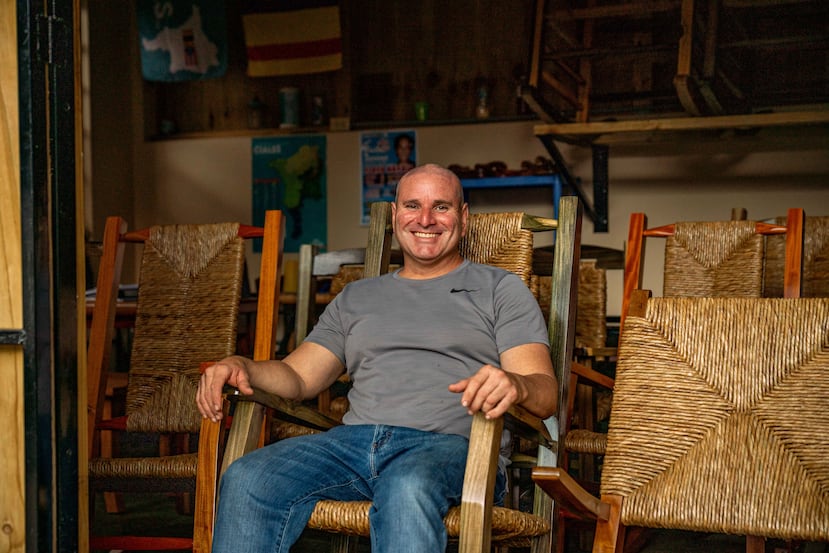

March 10, 2024 - 11:00 PM


Lee la historia en español aquí.
Ciales.- For more than a century, the Villalobos family of Ciales has been well-known for the quality of their furniture made with cattail and local-grown hardwood, in a meticulous process that begins in a mangrove in Manatí.
They visit three times a month to search for raw material in the shape of a herb that grows 10 to 12 feet tall. It must be cut during a waning moon after tying it around one’s waist, to avoid stepping on it by mistake, and making sure there’s no alligators nearby.
This is the essence of a tradition that has been preserved over time, weaving together knowledge that is passed from generation to generation.
“It is a great tradition that is more than 120 years old. It was started by the Troche family, who came from Santurce and settled in the town of Ciales. They were the ones who brought the wood and cattail furniture,” explained craftsman Juan Luis Villalobos Jiménez, 47 years old.
“Later, one of my dad’s uncles started. Then my grandfather, who passed away more than 30 years ago, learned from him. My uncle Guadalupe opened the workshop and David Villalobos, who has since passed away. His son stayed and now there’s Waldemar who is 42 years old; we’re cousins,” he said from his workshop, located in the Los Villalobos sector of the Cordillera barrio.
According to Villalobos, “we make all kinds of furniture out of local hardwood.” “We make rocking chairs, living room sets, sofas, loveseats, coffee tables, corner tables, dining sets and beds... we specialize in custom-made armchairs for obese, tall, or large people; the idea is for the armchair to suit the person well,” he explained, highlighting that he has 22 models of rocking chairs.
“We use our native Puerto Rican mahogany, we use the majó (Talipariti elatum) that is used to make cuatros and is great for furniture, capá prieto (Cordia alliodora), four types of laurel, teak, honeylocust (Gleditsia triacanthos), which is very abundant in Ciales, and the maga tree (Thespesia grandiflora), among others. But for furniture, these are the most used because the wood is more resistant to warping,” he explained.
Likewise, he highlighted that the most important thing about the process is that the wood and cattails are harvested during a waning moon.
“We use cattail to wrap certain parts of the piece of furniture. It grows in mangroves to about 10 to 12 feet tall, which is the ideal length for cutting. It has to be cut during the waning season to avoid pests. Everyone thinks that getting cattails is easy, but it’s actually expensive because each trip costs about $400,” he said.
“To fill this area we have to visit three times a month, because it is very difficult to spend more than five hours in the mangrove. There’s areas where the water comes up to the knees, and in others you step and your entire foot sinks. We’ve seen small alligators. The mangrove I usually go to is in a closed area, the water is still, but it’s clean, it doesn’t smell bad or anything,” he revealed.
The cattail is then taken to the workshop, where the leaves are separated, the unneeded residue is disposed of, and then the raw materials are hung to dry for around 20 days, so that they dry well.
“For the ‘empajillado’ process, which means to wrap the piece by hand, it is recommended to retrieve the cattail to be used in the morning; about five or six bundles. Then, you wet it so that when you are wrapping the piece, it stays damp and flexible. This prevents you from hurting your hands and makes the cattail more flexible. You start tying it and it starts looking like a little rope, and there’s the beauty of it, because not everybody knows how to make it look nice,” he said.
“For the wood, you have to choose the woodcutter carefully. It must be someone who likes to cut trees during a waning moon, because if it’s cut outside of that period, it gets infested with pests. You have to let the wood dry after it is sealed, because the tree contains water and, in order to use it, it has to be very dry to assemble the furniture,” highlighted the artisan, who is certified by the Puerto Rico Industrial Development Company.
The work is carried out by three cousins in the family workshop, where they make everything from the ‘empajillado’ to laying the wood, piece by piece, individually.
“The pieces have to be polished, sealed, assembled and wrapped with the cattail (‘empajillado’). At the end, I like to wash them so that the straw is clean. The arms and rockers are assembled, then sanded, blown, and cleaned well. A second coat of sealant is applied to make it glossy. It is a process. If you’re quick, the ‘empajillado’ process can take six hours.”
On the other hand, he admitted the need for more labor, as “young people do not want to learn. Technology is killing us.”
“With me, this workshop dies. But I want it to be known that anyone who wants to learn the craft can come and we will teach them,” he concluded.
For more information, call 787-943-1399.
Las noticias explicadas de forma sencilla y directa para entender lo más importante del día.

Te invitamos a descargar cualquiera de estos navegadores para ver nuestras noticias:
